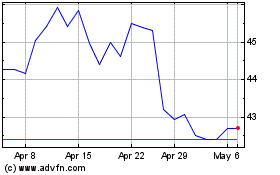BHP Annual Profit Drops by 58% on Commodity Price Pullback -- 2nd Update
22 August 2023 - 12:51PM
Dow Jones News
By Rhiannon Hoyle
Mining giant BHP said its annual profit fell by more than half
compared with a year earlier, reflecting a pullback in commodity
prices that has squeezed profits across the industry as China's
economy stumbles and big markets like the U.S. grapple with sharply
higher interest rates.
BHP, the world's biggest miner by market value, reported a net
profit of $12.92 billion for the 12 months through June. That is
down from a profit of $30.90 billion a year earlier when it had
benefited from the sale of its oil-and-gas business and when
commodity prices were at or near record highs. BHP said it also
continued to grapple with cost inflation, especially in labor,
diesel and electricity prices.
Analysts expected a profit of roughly $13.30 billion, according
to a Visible Alpha consensus compiled from 15 forecasts.
The miner cut its final dividend to 80 U.S. cents a share, less
than half the $1.75 paid a year ago. Shares in BHP were down by
1.5% around midday in Sydney.
BHP said its full-year cash payout of $1.70 a share is still its
third-largest ordinary dividend on record. Analysts had forecast a
total dividend around $1.72 a share, according to Visible
Alpha.
"BHP's external operating environment in FY23 was volatile," BHP
said. "Our key commodity prices were materially weaker leading to
lower revenue generation, while we also managed significant cost
inflation across the business."
BHP said its underlying profit, a closely watched measure that
strips out some one-time items, totaled $13.42 billion, down from
$23.82 billion in the previous fiscal year.
Commodity prices fell on concerns about economic growth in
China, the largest buyer of many metals and minerals, and the
outlook for developed economies after sharp increases in interest
rates.
The miner was paid 12% less for its copper last fiscal year
versus a year earlier and 18% less for iron ore, the key ingredient
in steel.
The average price for its metallurgical coal, also used to make
steel, was down by 22% after surging in 2022 in big part due to
supply concerns when Russia's invasion of Ukraine disrupted trade
flows.
Its own production was mostly higher. BHP produced more copper,
iron ore, nickel and thermal coal than the year-earlier period. Its
output of steelmaking coal was flat.
BHP's weaker profit mirrored results from rivals including Rio
Tinto, Glencore and Anglo American. Rio Tinto, the world's
second-biggest miner by market value, last month reported a 43%
drop in first-half net profit and cut its own payout to
shareholders due to weaker prices.
A drawn-out real estate crunch in China is especially worrying
for miners, given the importance of the sector to the country's
economy and metals demand.
"The main risk for BHP in the near term relates to the Chinese
economy," Jefferies analysts said in a note. A continued downturn
in the country's housing market could depress commodity demand and
prices, the analysts said.
Another set of disappointing economic data for July along with a
policy response that has so far underwhelmed have prompted a number
of global investment banks to lower forecasts on China's full-year
growth rate.
"The authorities have acknowledged that more policy support is
needed to fully embed the recovery," BHP said. "For FY 2024, the
key question is how effective this latest policy push will be."
Demand in China has, however, held up relatively well, the miner
said, and it expects both China and India to be sources of
stability for commodity demand in the near term.
By contrast, it took a more cautious tone on developed
economies, where it said demand for commodities has slowed
substantially in big part due to anti-inflation policies. "We
anticipate that these competing forces may have a variable impact
on commodity prices in the period" ahead, BHP said.
While rising expenses also eroded earnings last fiscal year,
increased costs industrywide should help put a higher floor under
world commodity prices, BHP said. "Overall, the cost of mining
production is now estimated to be higher than it was prior to the
pandemic."
BHP said it experienced an effective inflation rate of roughly
10% last fiscal year and projected further pressure in the year
ahead, particularly in labor costs.
Write to Rhiannon Hoyle at rhiannon.hoyle@wsj.com
(END) Dow Jones Newswires
August 21, 2023 22:36 ET (02:36 GMT)
Copyright (c) 2023 Dow Jones & Company, Inc.
BHP (ASX:BHP)
Historical Stock Chart
From Jan 2025 to Feb 2025

BHP (ASX:BHP)
Historical Stock Chart
From Feb 2024 to Feb 2025
